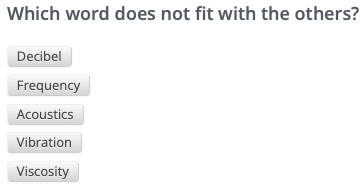Personality Tests
What are Personality-Tests?
Personality Tests are an important factor in the application process, especially in big corporations.
While skills tests can reveal a potential candidate’s cognitive abilities, personality tests provide prospective employers with insight into what a skills test and resume don’t show. What are the candidate’s personal strengths and weaknesses? How strong is his or her motivation for the advertised position? Is there a culture fit?
Especially when it comes to filling management positions, personality tests are very popular because certain qualities are required, especially in these positions. Someone working as a manager or boss should be dominant, proactive and open to new things within healthy limits. So, to see if the candidate brings such qualities, many companies use personality tests.
In addition to management positions, personality tests can also be used for any other position to see to what extent the candidate has soft skills (such as team ability), work ethic and manners. Also how the general attitude of the candidate and his or her decision-making ability is, can be interpreted by personality tests.
It is also particularly important for the company to see how much the candidate fits into the company, i.e. whether there is a human and professional fit – in other words, whether there is a cultural fit.
Who offers personality tests?
If you are invited for an assessment test in the near future, it is quite possible that you will also take a personality test.
The well-known providers of typical skills tests usually also offer an additional personality test.
So, should you be facing a skills test from the following providers, it is recommended to also look into the additional personality tests:
At Test The Talent, you can prepare extensively for the skills tests from these test providers so that you can get your best possible score on the final test.
Personality tests are a bit different. Preparation is only possible to a limited extent, because this type of test examines your personality, which is difficult to influence. In addition, there are no right and wrong answers.
In the following, you will learn why it still makes sense to deal with personality tests, which ones are available and how they are structured, whether you can still prepare yourself to a certain extent, and which personality companies look for in the application process.
Can you prepare for a personality test?
Yes, you can! But you cannot train for it, nor can you influence the result.
The test reveals your personality and gives the recruitment team important information about whether you fit the job position. Since you can’t really train your personality, you can’t train for the test.
What you can do, and should do, is study the structure of the test, the values of the company, and the tasks of your desired job. You should ask yourself what is required in this position, and whether and to what extent you possess these qualities. Possibly you can also consider in the previous what the company wants to hear and answer the questions accordingly. However, you should do this only to a certain extent, because in the end the test will show whether you have enough qualities where it is needed in the new position or not. So if you answer the questions the way the company wants to hear it, when you get the job, it will eventually be evident. So rather try to answer the questions as honestly as possible and prepare extensively for the associated skills test.
These companies offer the following personality tests:
SHL
SHL OPQ32 – Occupational Personality Questionnaire
In this test you have to answer questions related to your behavior, which in turn provide information about your character traits and show whether they match the qualities required in the position in question. You will be given four statements for each question and must indicate which statement you agree with the most and which the least. There is no time limit. As a rule, candidates need around 30-40 minutes to answer the total of 104 questions.
PICA
PIBA Behavioral Assessment
The test takes about 5-10 minutes and contains two different parts. Part 1 lists 86 adjectives. You are asked to choose the adjectives that most closely reflect you and your behavior. Part 2 includes the same list of adjectives, but this time you must indicate which adjectives others would use to describe you. Your answers from both parts will be compiled into a profile, which will be sent to the company where you are applying. This gives the company insight into how you will behave in certain situations and whether you fit the advertised position, purely in terms of your personality.
Cubiks
Cubiks Factors
Based on the „5 big Personality traits“
PAPI N: PAPI Normative
Known as first candidate screening to see who tends to fit. You are given statements and have to indicate how much you agree or disagree. There are no right or wrong answers. The answers of all candidates are compared with each other and patterns become apparent that show which candidates are more likely to be considered for the open position.
PAPI I: PAPI Ipsative
Used more often later in the application process. You are asked a question and you have to choose the answer that fits you the most and the one that fits you the least. The answers will determine your work direction and behavior.
Saville
Wave personality Questionnaire
Considered a strong indicator of how the potential candidate will do later in their career, as well as whether there is a culture fit with the company in question. The test includes statements with which the candidate either agrees or disagrees.
Situational Judgment Test
Involves various realistic scenarios to see how well the candidate fits the advertised position. The candidate is observed how he/she reacts to them. This type of test is very individual, as each test is tailored to the company.
Thomas International
Personal Profile Analysis (PPA)
This personality test measures your personal traits and sorts them into four different areas. These include dominance, influence, consistency, and learning ability. For each question, you will be given four answer choices, each of which will be added to one of the four character traits. At the end, each candidate is given three profile overviews that include the traits the candidate has, the ones they don’t have, and a combination of both.
Big Five Personality Test
ncludes 120 statements where you must indicate to what extent you agree or disagree with the statement. The Big Five Test is considered one of the most scientifically validated personality tests. It is also called the OCEAN Model and provides information about the following character traits:
O – Openness: tolerance, curiosity.
C – Conscientiousness: Attention to detail, planning, etc.
E – Extraversion: The ability to be extroverted.
A – Agreeableness: Indicates how good someone is in dealing with others.
N – Neuroticism: Says about how anxious someone is, especially under stressful situations).
What personal characteristics do companies look for?
Companies try to gain insights into the personality of potential candidates with a personality test. Which characteristics the company focuses on depends very much on the individual job position. In general, however, it can be said that clear strength of character in the following characteristics is an advantage:
- Motivation. Both in relation to work, but also in relation to your life. If you want to see a lot, learn new things, make new acquaintances and have many different interests, these are all signs that you bring a lot of motivation and enthusiasm with you.
- Work ethic and general manners. The basic qualities that are probably required in any position. It’s important for the company to see that you act in the company’s best interests, and most importantly, that you fit in with the company’s values and standards
- Team Ability. This is about how well you can cooperate in a team. Whether you tend to prefer working alone or with others and whether you are supportive of other members or more of a lone wolf.
- Dominance and intuitive action. These character traits are especially in demand in management positions. So if you aspire to a position in management, you should have a certain amount of leadership, as well as intuitive action in more difficult situations. This also includes making important decisions, as well as the ability to pull others along and motivate them.








